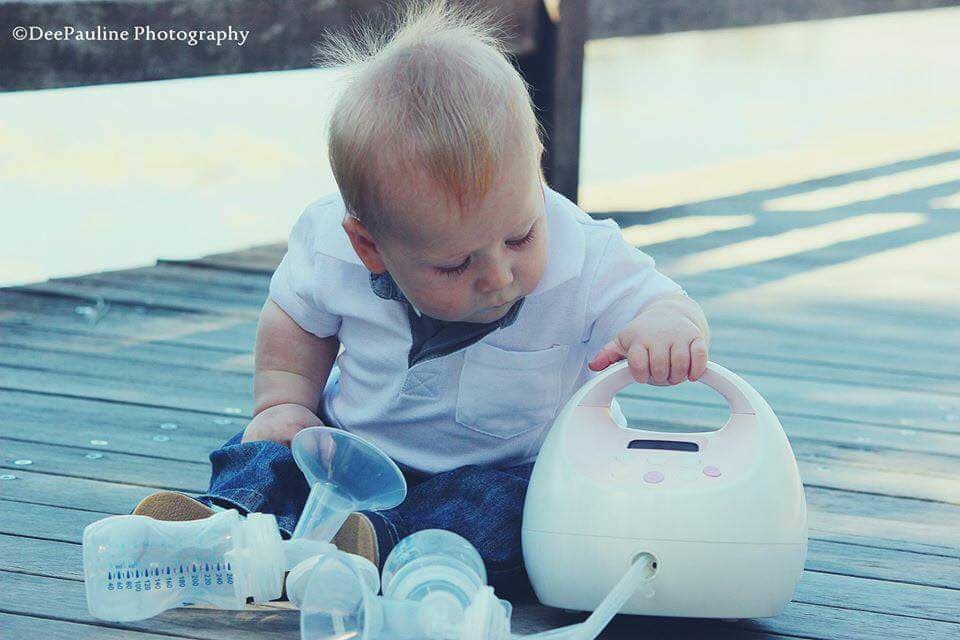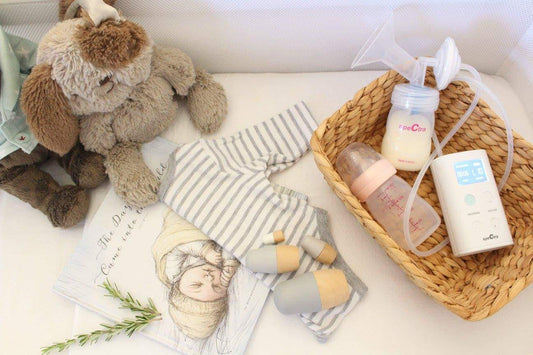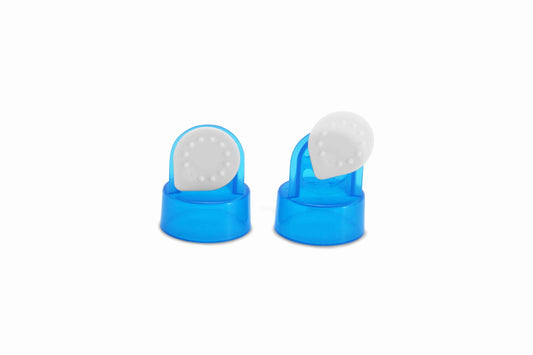1. My Spectra breast pump won’t turn on or charge!
If you’re plugging in your Spectra breast pump to mains and it’s not turning on, or if you have a rechargeable breast pump and it’s giving you no indication that it’s charging, the number one culprit for this is the power adaptor. Make sure the 'prong' part is clicked right in to the rest of the power adaptor. Slide it down, and you will hear (and feel!) a loud clicking noise. When correctly installed, it will take a considerable amount of oomph to remove it, and the regional adaptor will not be visible from the back side of the adaptor. Whenever someone writes in saying they have a new Spectra pump that isn't charging / powering on, we know it's going to be the power adaptor not being clicked together all the way! Give it a go and hopefully you'll be up and pumping.

2. Suction on my breast pump has dropped
It's really common for mums to notice a drop in suction over time, or feel like the breast pump isn't working well anymore. Unfortunately a lot of the time people think it's a problem with the breast pump, or even worse, that their supply has dropped. If you're experiencing low suction on your breast pump then it's generally due to parts needing replacing. Over time, the elasticity of these parts wear down causing them to lose effectiveness. The number one part responsible for this are your valves. These need to be replaced every couple of months for mums who pump occasionally up to every 2 weeks for a mum exclusively pumping. If you can visibly see any fraying or stretching on your valves then you can be pretty sure they're the culprit. Inspect your pump parts regularly for any deterioration and expect to be replacing them from time to time - but you will not "see" when your parts are deteriorating or need replacement 99% of the time. Click here for a guide on when to replace membranes and other breast pump accessories.3. My breasts aren’t draining / I’m not getting much milk
We know this is so frustrating! There are a few reasons this could be happening, but the first thing to think about is shield fit and positioning. Spectra pumps come with 24mm size breastshields which work well for most mums at least initially, but this can change over time and it might be time to explore your best shield fit! It's very possible you need a different breastshield size throughout your pumping journey. You can try gauging your breastshield size by measuring it (full guide in this post) or message us for help. The following diagram is an example of what a shield might look like if it's too small (left), too large (right), or as an ideal fit (center).

If you've read through our breastshield sizing guide and you're still not sure, please just message us or comment below and we'll try to help out. Other than shield size, here are a few more things to consider if you're not getting the milk output you'd like to be getting:

Have you experimented with your pump settings?
If your shield size is comfortable and seems to be correct, then this could be an issue of not using the settings that work best for you. Like determining shield size, working out the best pump program for you is largely trial and error, but it can make a huge difference. Finding that 'sweet spot' in the pump settings that your body responds to best will really help. You can expect to need to change your settings throughout your pumping journey and this is to be expected and will be necessary as your baby gets older and pumping naturally gets harder. Our body's hormones change as our baby gets older, and responding to a pump will get harder, even with the best routine, nutrition and hydration, shield fit, technique, sizing etc. Many mums exclusively expressing need to fight this tendency by pumping more often and longer, paying attention to nutrition and much more, to minimise the drop in output and letdowns as best they can. Start in massage mode at a low vacuum setting, and gradually increase vacuum to your maximum comfort level: determine your maximum comfort level by identifying the vacuum level at which you start feeling discomfort, then turning it down one level. This is your maximum comfort level (for example, if you feel discomfort at vacuum level 5, vacuum level 4 is your maximum comfort level). Do not pump higher than your comfort level. Once your letdown happens, try switching to expression mode at the same vacuum level. Some mothers find success staying in massage mode the entire time, while others find success switching back and forth between massage and expression mode multiple times per session. Play around with the settings each time you pump to see if you get different results.
Breast compressions
It is a reality of breast pumping that most women will do better if they double pump and do breast compressions whilst pumping, and for some women it's a non-negotiable. You may find that you are someone who needs to do breast compressions when you pump. Unfortunately this is going to make the whole pumping thing even more laborious, but if you can make it work it will really help. Apply gentle pressure in a circular movement beginning and the top of your breast and working down toward your nipple. Don't massage under the shield, and don't forget the area in your armpits. Tip - look on YouTube for some tutorials on how to do breast compressions.The age of your baby / how many babies have you had
As a general rule, the older your baby is before you try pumping, the harder it may be to get your body to respond to a breast pump . If your baby is older, or you breastfed for a long time before, then we really encourage you to think about getting the S2 or the S2. These pumps have a bigger motor that allows lots more different program options, so you're more likely to find the settings that work well for you.Did you just swap from another breast pump model?
It's frustrating, but it's really normal for it to take up to a week or two to get used to a new breast pump. The best way to do this (and we know this is hard) is to just give yourself some time. Persevere, try not to get anxious about reduced milk output / disappointing results, keep going and hopefully your body will adjust and you'll be off and running with your new pump.4. I’m hearing a squishy noise while pumping
A squishing sound is usually caused by pump parts not being completely dry prior to assembly or needing replacement. Depending on where the moisture is, it can impact suction, or worse, get into the tubing. It’s important to allow enough time for pump parts to completely air dry prior to assembling. If you’re a frequent pumper, we recommend investing in a second accessory set to ensure that you always have clean, dry pump parts on hand.5. There’s moisture in the tubing
Moisture or condensation in the tubing is usually caused by parts being assembled while still wet or incorrectly. Ensure that when you wash your parts, you leave them ample time to air dry, and completely dry prior to assembly. For frequent pumpers, we recommend having an extra milk collection kit so you always have clean, dry parts available to use.Check your backflow protector
If your parts are completely dry prior to assembly, but you notice moisture in the tubing during and after pumping, it's most likely an issue with the valve or backflow protector. Improper assembly of the backflow protector, a broken or worn out valve or backflow protector, or forgetting to use the valve or backflow protector all together will allow condensation to built up while pumping. It is very important to use the backflow protector because once moisture enters the tubing, there’s no way to safely clean, dry, and sterilise it or the moisture in the pump itself. You risk getting moisture into the pump motor itself, which can cause irreparable damage, or worse - mould! Backflow protectors need to be replaced regularly to prevent this from occurring. For frequent pumpers, we recommend having extras on-hand for when you need them.6. I’m feeling a reduction in suction while double pumping
If you’re noticing a reduction in suction while double pumping vs. when you single pump, this is completely normal. However, if it gradually gets worse, then it probably means it's time to replace your parts. Worn down parts tend to fare better while single pumping, but when double pumping will deteriorate more. Also, your nipples will become less senseitive over time, and you will tolerate higher suction levels more easily, as your hormones change so don't always assume your suction is not working if you need higher suction levels.But why is it normal to feel a difference?
It is normal to notice a consistent difference in vacuum pressure between single and double pumping, especially at higher vacuum settings. Here's the science behind it: The pump motor is built so that air is sucked through a single tube on each cycle. When the breastshield is placed over the nipple, that sucking creates the vacuum effect which draws milk from the breast. When double pumping, this airflow is split into two channels, which both go to the same single tube at the motor. This causes a reduction in suction on both sides. When single pumping, the extra air port is covered by a cap making it so there’s only one path for air to travel between the breast and the motor. There’s no splitting therefore no reduction in suction. If you’re experiencing a reduction in suction at your usual settings while double pumping, try turning the suction level up - but remember, never pump higher than your comfort level :) It's important to know that the benefits of double pumping offset the reduced suction with double pumping, as double pumping encourages more let downs. So don't panic... it's still ok!7. There’s no suction when I’m pumping!
If you’ve ever noticed a sudden loss of suction while pumping most commonly it’s because the duck valve or valve + membrane set is not attached correctly to the breastshield, or has fallen off, or the tubing has slipped.Are your backflow protectors still moving when your pump is on?
If the backflow protectors are still moving back and forth with the sucking motion of the pump, then chances are the suction issue is because of the membranes or valves. When they lose suction or fall off it’s usually because they have worn down and it's time to replace them. Check to make sure your membranes are still properly assembled to your kit, and remember that to properly maintain the pump they do need to be replaced regularly.Are the backflow protectors not moving?
If the backflow protectors are not moving, it's possible the tubing has slipped off and dosconnected. Verify that the pump kit is assembled correctly and try again. If you don't see any suction movement in the backflow protectors, contact customer service.






1 comment
My pump is not suctioning at all. I have checked all the parts. There’s literally no air coming from the tube.